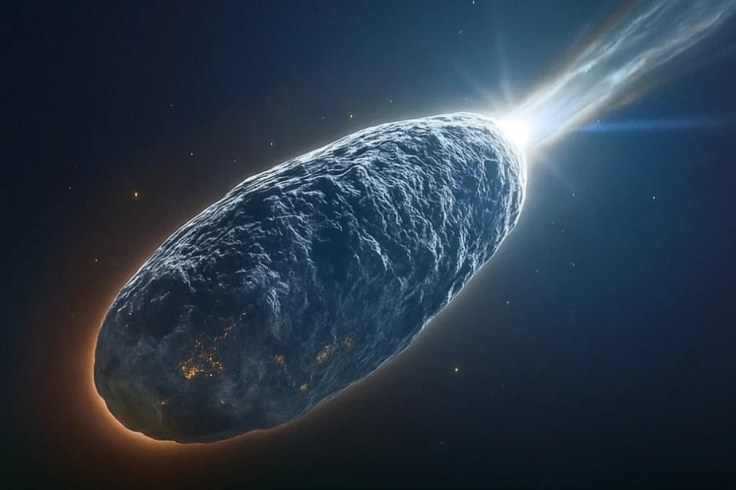3I/ATLAS: Amateur Astronomers Spot Continuous Motion, Surprising Experts
The interstellar comet 3I/ATLAS is scientifically crucial as the third known object from beyond our Solar System

An unexpected discovery has recently shaken the world of professional astronomy. While studying the mysterious object 3I/ATLAS, often called the 'interstellar comet', amateur sky-gazers were the first to detect its continuous, unmistakable movement across the cosmos — a finding that has genuinely surprised and intrigued experts worldwide.
The online community has erupted with enthusiasm after fresh pictures and clips of the interstellar comet 3I/ATLAS emerged on astronomy message boards, in official NASA updates, on ESA observation channels, and on various social media platforms.
The Comet That Captivated the Web
Numerous posts suggest the comet appears to be spinning, with visuals showing dust bands, separated layers, or circular movement.
The reality, as a Zee News report points out, is that scientists have not confirmed any of these reports. Nevertheless, the intense chatter online has greatly increased interest in the swift-moving object crossing our planetary neighbourhood now and will never return.
How the '3I/ATLAS Is Spinning' Idea Took Hold
The initial speculation began when people taking space photographs and hobbyist sky-watchers posted videos that seemed to show a turning motion around the comet. Key examples of the viral posts include:
Video Suggesting a Rotating Shape
A viral post drew a parallel between the activity surrounding 3I/ATLAS and an older clip from the ESA ExoMars Orbiter, suggesting that the newer visuals might indicate spinning. The recording, credited to Diego San Araujo, has yet to be confirmed or peer-reviewed by scientific organisations.
🚨 3I/ATLAS: NEW FOOTAGE!
— 3I/ATLAS WHISTLE BLOWER (@3IATLASEXPOSED) November 21, 2025
New footage clearly shows a spinning structure.
Alot like what was captured by ESA’s ExoMars Orbiter.
Do we have confirmation this is not a comet?
Source 📸 : Diego San Araujo#3IATLAS #3IAtlasExposed #Space #UFOx pic.twitter.com/fPmJSAdhi3
Astrophotographer's Video Shared at 9 PM EST
Another report suggested that a new video submission depicted the comet 'revolving'. The post also noted that NASA was set to publish new, authorised images during an online event later in the week. Exciting news, certainly, but still unconfirmed.
BREAKING🚨: An amateur astronomer (Ray's Astrophotography /Youtube) shared a video at 9pm EST that included these images of 3I/ATLAS.
— All day Astronomy (@forallcurious) November 19, 2025
This is relevant since we will be getting new images of 3i/ATLAS from NASA during a live event scheduled for 3pm EST Wednesday.
Ray says that… pic.twitter.com/5cDlDCKu4z
Stacked Photos Appearing as Five Objects Moving Around a Centre
A single person combined numerous long-exposure photographs and noticed a pattern resembling five separate masses orbiting a central point. Specialists commented that changes in the coma, dust streams, and activity from the nucleus can easily produce similar deceptive images.
In the latest capture, 3I/ATLAS shows a motion pattern that resembles five objects circling a center.
— Space and Technology (@spaceandtech_) November 18, 2025
Stacked images reveal shifting coma patterns, dust jets, and inner-core movement that create this rotating effect.
Video Credit: Rays Astrophotography pic.twitter.com/DvVDdkBQG1
Reports of 'Flawless Dust Rings' Measuring 150,000 km Across
Another widely circulated picture showed five dust bands spinning around the comet, described as separate layers. This striking assertion is also unsupported by official sources. Although these posts lacked supporting evidence, they have sparked speculation worldwide.
Before NASA releases its official image, a new photo of Object 3I/ATLAS has come out from Ray’s Astrophotography, and people are definitely noticing something odd in it.🧐🤔☄️☄️☄️☄️☄️☄️ pic.twitter.com/p9r0N40hhP
— UFO mania (@maniaUFO) November 19, 2025
🚨 3I/ATLAS: DETATCHED SHELLS!
— 3I/ATLAS WHISTLE BLOWER (@3IATLASEXPOSED) November 18, 2025
5 perfect dust rings swirling 150,000 km around the nucleus.
I have never seen anything like this..
INSANE!
Credit 📸: Ray's Astrophotography#3IATLAS #3IAtlasExposed #Space #UFOx pic.twitter.com/Da1BpkoLn7
READ MORE: NASA Responds to Viral 'Alien Ship' Theory After Baba Vanga Prediction Resurfaces
READ MORE: 3I/ATLAS: NASA Defends Its Fuzzy HiRISE Images As Amateurs Produce Sharper Views
The Established Facts Concerning 3I/ATLAS
The discovery of 3I/ATLAS was made on 1 July 2025, thanks to the ATLAS survey telescope in Chile. NASA quickly verified two essential details:
- It holds the distinction of being the third documented interstellar object, following in the path of 'Oumuamua (2017) and Borisov (2019).
- Its path is defined by a hyperbolic orbit, confirming its origin outside the Solar System and ensuring its perpetual departure.
Furthermore, data collected by both NASA and ESA confirmed the comet's speed exceeds 210,000 km/h, a velocity too great for it to be gravitationally bound by the Sun.
3I/ATLAS: Trajectory, Velocity, and Observation Details
Following its perihelion on 30 October 2025, 3I/ATLAS is now moving back into the pre-dawn sky as viewed from Earth.
Observational Requirements:
- Location: The low eastern horizon just before dawn.
- Equipment: A minimum of an 8-inch telescope is required for viewing.
- Prime Viewing Window: The months of November and December.
- Nearest Planetary Encounter: It approached Mars, passing within 29 million km (October 2–3).
It is not visible to the unaided eye. Earlier in its journey, its distance of 1.8 AU made it too remote for detection by smaller telescopes.
Why 3I/ATLAS Holds Great Scientific Value
Astronomers believe the comet likely has elevated carbon dioxide levels, suggesting it formed in a very cold region of a remote star system. Consequently, it offers a valuable opportunity to examine pristine matter originating beyond our stellar neighbourhood.
Key implications of its interstellar origin are:
- It has no predictable periodic trajectory.
- It is a non-returning visitor.
- It provides a singular opportunity for observation.
Since close encounters with interstellar objects are infrequent, the value of each measurement obtained is immense.
READ MORE: Harvard's Avi Loeb Says 3I/ATLAS Visit Is Like A 'Blind Date Of Interstellar Proportions'
READ MORE: ISRO Captures 3I/ATLAS in Unprecedented Detail — A Quiet Event With Big Impact
The Unverified Conundrum: Is the Comet Turning?
While the core facts about 3I/ATLAS—its interstellar origin, its frigid composition, and its singular passage—are now firmly established, this transient visitor continues to spark debate among observers worldwide.
Amateur and professional footage has recently circulated, suggesting an unusual rotational pattern within the comet's coma.
These visual anomalies, interpreted by some as shifting shapes or structured dust rings, have naturally led to a pressing, fundamental question that cuts across the verified data: Is 3I/ATLAS actually spinning, and if so, what does its rotation reveal about this object beyond our star system?
© Copyright IBTimes 2025. All rights reserved.




















